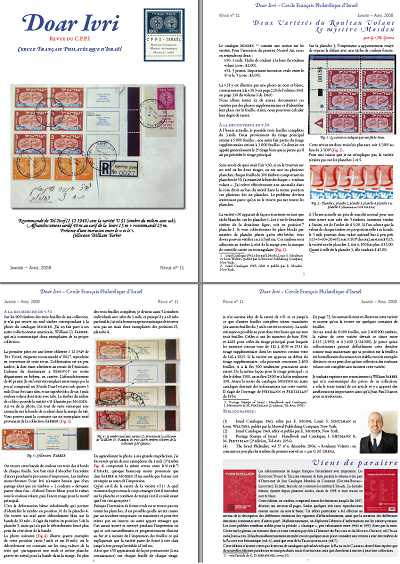
The cover shot came courtesy of long-time collector, William Farber. It is undoubtedly the most magnificent & valuable Flying-Scroll cover I've ever seen.
It's not just a colorful, well-organized arrangement, & not just a rare tab block on cover, but a block that allowed me to identify the position of a seldom-seen error--an oval blob between the Shin & Resh of the Hebrew rendition of "Israel" on the stamps (as you can see, they're trilingual). In this specimen, the error lands dead center in the block! Simply spectacular, regardless of whether the original sender knew about the error or not.
Back in the early 1960s, Mosden published a major philatelic catalog containing all kinds of minor varieties ignored by typical catalogs that only focus on regular/normal issues. Mosden recorded both errors that I discuss in this article, which is entitled "Deux Varietes du Rouleau Volant: Le Mystere Mosden" ("Two Varieties of the Flying Scroll: The Mosden Mystery").
The 1st variety, #50 in the Mosden catalog, is a printing-plate anomaly limited to the 3-mil sheets, which were the first ones printed back in 1948. The sheets contained 6 subdivisions--panes. Two of those panes were normal (#2 & #5), but 3 of them contained a blank spot in the 2-winged icon's tail (#1, #4, & #6). Pane #3 contains a unique dark spot.
It's possible that Panes 2 & 5 were fabricated first since they're positioned in the center of the sheet. Then some anomaly might have appeared on Pane 3; its raised surface would pick up the ink. Then the master was cleaned, & this removed the anomaly, but left a vacancy on the plate such that no ink could adhere to it during printing. Of course, this scenario is a figment of my imagination, & we'll probably never know for sure what happened, or what caused the problem.
The important thing is that this is the first time in philatelic history that the location of this particular error has been described (shown in Fig. 1 on p. 5), & photographed in color with high magnification for all 6 panes, showing them side by side (in Fig. 2 on p. 5). In fact, you can still see the white dots even in the lo-res photo here in my blog, though in the published article, you can see every individual color dot from the original printing!
The Mosden catalog did, however, contain a small black-&-white photo of variety #51, but again lacked a description of its location. The now-famous Farber cover provided a key clue, & thanks to my collection containing 3 complete sheets, I was able to pinpoint it, even though none of my 3 sheets contain the error! Apparently it occurred during the middle of the print-run, which produced about 8,000 of these 3-mil sheets.
So how many sheets contain the error? That's another mystery belonging to the King! In the article I narrow it down to anywhere from 100 to 2,800. An extremely rare philatelic catalog published in the mid-1950s speculated that it appeared on "a few hundred sheets".
But how was I able to identify its precise location on the sheet of 300 stamps? Ah, that's a mystery that everyone can solve by simply becoming a member of Cercle Francais Philatelique d'Israel, & obtaining a copy of this particular issue of their fine journal!
Song of the week: "Mystery" by Anita Baker (click the song title to visit Amazon; click here for a 29-second sample; 361kb).
G.M. Grena

No comments:
Post a Comment